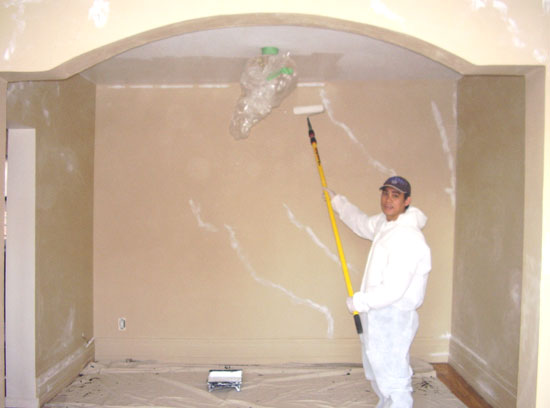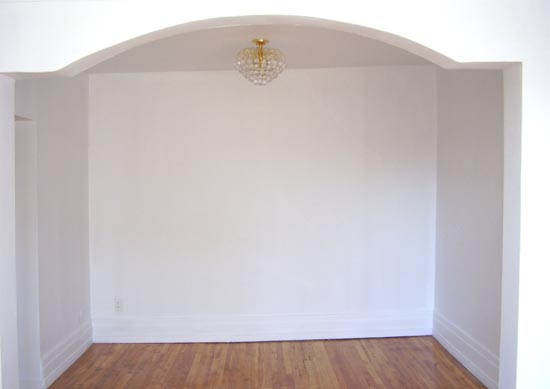Painting Walls and Ceiling
Painting interior walls is the easiest way to freshen up your place. A successful paint job starts with properly preparing the mural, scraping, sanding, patching and filling every holes, cracks, dents and surface imperfection.

Preparations are always required, if it is processed a professional look is easier to achieve, with the kinds of paint rolers texture can be a choice wether it is a rough or smooth finish. Giving a primer coat will illuminates the top layer of colored coat and gives an opaque surface, some paints are avalable with primer and paints mix together. Type of paints may effect the ambience of the room and the choice of finish paint of flat, matte, eggshell, satin, velvet, semi gloss and gloss are important. Most of the ceilings are suggested with matte finish because it removes glare separating and giving a chandelliers a focal attention and hides some of curves and distortion of the ceilings. The best effect for walls are eggshell, satin and velvet. For trims, borders, doors, closets and bathrooms are semi gloss and gloss because it gives an advantage of bouncing dirts, humidity and comfortable cleaning without damaging its appearance.
Visualizing the colour is the interior decoration taste, all colors are beautiful, harmony and getting the right color motif needs a careful study considering decors, furniture and floors. Decorator, artist and paint sellers are reliable sources for any suggestion.

Selecting paints:
There are two main types of paint depending on the thinners and binders used; water-based (or latex) and oil-based (or alkyd).
Water-based paints use water as a thinner. They are often called latex paints even though they don’t use real latex, since rubber is not used as a binder any more. Today synthetic latexes are used, most commonly acrylic or polyvinyl acetate. Paints with a high acrylic content tend to have a tougher skin and can perform almost as well as oil-based paints. Latex paints can be easily cleaned up with soap and water.
Oil-based paints use a solvent thinner. Despite the name, oil-based paints are usually not made with oil. Instead, most use polyester resins, called alkyds. Although alkyds may be more durable and achieve a higher gloss finish, they are usually a less healthy choice than latex. Alkyd paints require mineral spirits for cleaning up.
Because paints are applied wet, and because they cover such a large area, paints can create a significant health problem during a renovation project. The problem is mainly caused by alkyd or solvent-based paints. They give off a number of volatile organic compounds (VOCs) as the solvent evaporates after painting.
These VOCs can be a strong irritant and can add to air pollution. Once the paint has completely dried and formed a tough skin, the emission levels drop. However, some paints can emit odours at low levels for a long time.
Exposure to VOCs varies from person to person. Effects include coughing, headaches, dizziness, or more serious conditions. It is especially important for respiratory sufferers, those with allergies, asthma, and households with young children or pregnant women to avoid paints with VOCs.
Comparing the VOCs of one paint to another is not an easy task. Material Safety Data Sheets (MSDS) are helpful, but manufacturers don’t have to list components which make up one per cent or less of their product’s weight. This means that some toxic components may not show up on the MSDS. The only sure way to know what the paint contains is by asking the manufacturer to list trace compounds.
There are some paints on the market that are solvent and VOC free. Look for the key words: Low VOC, or better yet. No VOC.
Types of paint:
It can be confusing when selecting the sheen of paint you want since the term used for the sheen varies by manufacturer.
Low-sheen (low-gloss) paints have none to little observable sheen. The amount varies slightly by manufacturer. Low-sheen paints can be called: flat, matt, eggshell, satin and velvet.
Higher sheen paints are semi-gloss, gloss and enamel. They have the most visible shine to them.
Low-sheen paints can be washed, but with care, higher sheen paints are the most washable and have the most durable finishes.
Most people select semi-gloss or high-gloss paints for rooms with high moisture levels such as kitchens and bathrooms, and high traffic areas such as main stairways and halls. Most people prefer to use semi-gloss or high-gloss paint on windows, trim and doors.
Bedrooms, dining and living rooms are more commonly painted with lower sheen paints.
Years ago, enamel meant oil-based paints.Today the term enamel can also mean durable latex paint.
Sealers are primarily used on new wood or masonry surfaces. They seal the surface of the material, forming a base coat which keeps the topcoat from being absorbed unevenly. They can be used to encapsulate materials to seal in gases thus preventing them from offgassing.
Primers are used to make the substrate more uniform, and to create a tight bond between the topcoat and the surface to be painted.
Cementious or masonry paints are used on concrete walls and floors.
Ceiling paints are designed not to drip.
Melamine paints are used for cabinets and shelves, and are very durable and washable.
Choosing paint by the brand is not enough. Many brand manufacturers make higher and lower quality lines of paint. As you move up in quality so does the price. Each grade is usually a few dollars more expensive than the previous grade. Avoid mixing the brands by using the primer of one brand with the finish paint of another. Paint will adhere better if you use the same brand for both applications.
If you buy all the paint you need at one time you have a better chance of getting a uniform colour.
Brushes and other tools
Ensure the rollers and paint brushes you buy are rated for the type of paint you are using. Better quality brushes help ensure that the paint strokes are less visible.
Estimating how much paint you will need:
Measure the height and width of each wall to be painted then multiply to obtain the square footage.
For rooms with lots of windows and doors deduct the square footage of the windows and doors.
A 4-litre (1 gallon) pail of paint will usually cover 37 square metres (400 square feet).
When calculating how much paint to buy, check how well it is expected to cover the surface to be painted. This is called hiding quality. Painting over very dark colours may require using primer as the first coat or more coats of paint.
Having the primer tinted the same colour as the finish coat can provide better hiding qualities.
Latex based paints should not be stored for extended periods of time as they can go bad. When buying paint look for the most current date of manufacture on the container.
|

